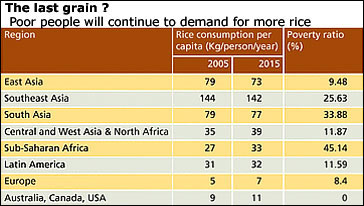Rice index
 • Annual rice production falls short of demand by 50 million tonnes. Annual growth in rice yield declined from 2.5 per cent during the green revolution (1960-70) to 1.1 per cent since 1980s, while global population grew by 1.4 per cent
• Annual rice production falls short of demand by 50 million tonnes. Annual growth in rice yield declined from 2.5 per cent during the green revolution (1960-70) to 1.1 per cent since 1980s, while global population grew by 1.4 per cent
• 90 per cent of rice is cultivated in Asia. But 55 per cent of Asians will be in urban areas by 2025, taking over some of the most fertile rice-growing areas
• Rice consumption is already on the decline in south Asia and southeast Asia. China, India and southeast Asian countries have taken to diversified food like wheat, vegetables, meat, fruit and dairy products with rising income levels
• Thailand and Vietnam have a major market in Africa, which accounts for 40 per cent of Thailand's total exports since 2000. 48 per cent of US export to Africa is through food aid programmes
• Sub-Saharan Africa, where most of the new demand comes from, is getting poorer. Per capita consumption has doubled since 1970
• People earning less than US $I a day rose in sub-Saharan Africa by 29 per cent during 1970-2000, but fell by 65 per cent in Asia
• 43 per cent of rice is cultivated in rainfed area and overlaps with concentrations of poor people. 75 per cent of the world's poorest depend on rice
• Each hectare in sub-Saharan Africa with 16 per cent irrigation yields 25 per cent of one hectare in the developed world receiving 100 per cent irrigation
 |
| Sources: Bringing Hope, Improving Lives, Strategic Plan, 2007-2015, 2006; and Rice Knowledge Bank (online), International Rice Research Institute |
Related Content
- Assessing the vulnerability of national food security to international food price shocks: a new index
- Tackling food inflation: is restricting exports and imposing stocking limits the optimal policy?
- Cost of a plate of food 2020
- Assessment of climate change impact on rice using controlled environment chamber in Tamil Nadu, India
- Fixing food: towards a more sustainable food system
- Flood, landslide damage 35,804 hectares paddy, vegies
